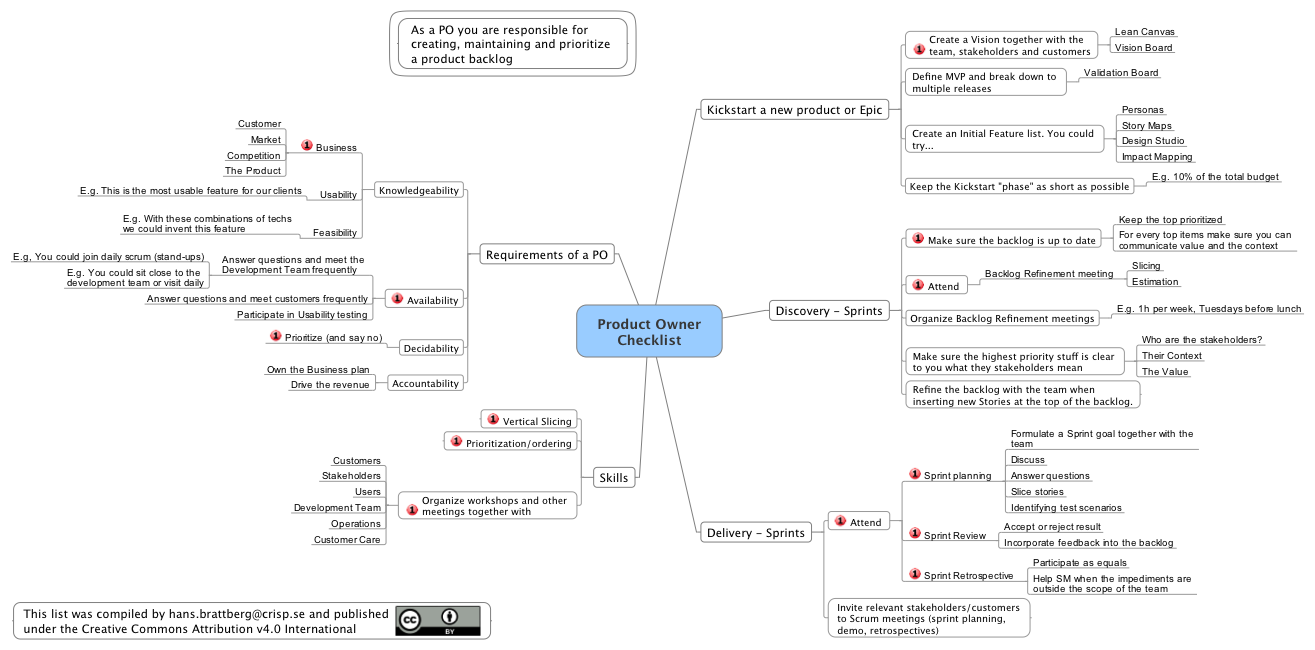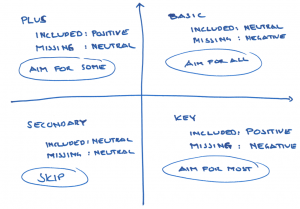If you wonder what a Scrum Product Owner need to do, here’s the checklist (in form of a mind map) for you!
Guest blog by Ellen Gottesdiener: It’s the Goal, Not the Role:The Value of Business Analysis in Scrum
Ellen Gottesdiener is an internationally recognized leader in the collaborative space where agile requirements + product + project management converge. She coaches, trains, and presents to thousands of people globally and has facilitated hundreds of discovery and planning workshops across diverse industries.
She will hold her popular workshop in Stockholm 25-27 September 2013.
It’s the Goal, Not the Role:The Value of Business Analysis in Scrum
In agile development, what happens to the traditional business analyst? Consider Scrum, currently the most popular agile method. In Scrum, there is no “business analyst” role. In fact, there is not an explicit role for tester, project manager, architect, developer, data administrator, user experience designer, customer support representative, or product trainer. Instead, Scrum has three roles: the product owner, the Scrum Master, and the delivery team. Their collective goal is to deliver high‐valued product needs continually. So, where and how can a business analyst contribute?
Establishing the first common product backlog
The past few days at my current coaching assignment have been great. We created a new backlog for all work they need to accomplish in the months ahead. The meetings where we laid the foundation for the future were marked by a high degree of collaboration between the participants and energy. It has been really fun to work with them so far.
Product Owner’s Product and Project Board
The team has its Scrum board as an information radiator. It is an excellent way of getting an overview of the sprint. But what about us, the product owners, don’t we need that too? Of course we do, we too have a need for an overview of our work and to radiate information. The stakeholders pass by and ask “what’s in next sprint”, “when will we migrate”. We’d like to just answer with a light gesture towards the wall. It is all there for everyone to see.
Let me tell you how our project owner board works, as an example.Continue reading
Becoming a Product Owner, Part 2
Here is part 2, a week has past. I think as I write so it is a bit different in style and content than my other posts here.
It has been a hectic week, this first week as PO/SM. First of all, it was only four days thanks to national day. Then there were two new developers from Russia which meant twice as many developers as we had before, not counting me. Simple, you just tell people to pair program. That works out if they are well enough to come to work. Which they weren’t. So they russians were left a bit hanging. I had a lot to do just to keep the team running, at least according to my standards.
The Product Owner team
In my opinion, the Product Owner (PO) role is the most demanding one in Scrum, since the PO needs to have so many talents and you rarely find all of them in one single person, so in my current team we formed a PO team instead.
Continue readingBecoming a Product Owner, Part 1
I am programmer and Scrum Master but has been offered to become Product Owner for the same part of the product I am currently working on. I decided to accept the offer and this is my live story, written as I go. Perhaps this will be of interest to you.
First of all, to me, this was not a decision I took lighthearted. However, I do have the fortune of peer coaching at Crisp and the offer came the same morning we had our last coaching. That was a timing like there was a meaning behind.
It is not supposed to be full-time either, so I need to choose what I shall do the rest of my day. It turned out that initially there was no choice. It was not possibly to find a Scrum Master to fill in my gap. The next sprint I will be both PO and SM. Hua!Continue reading
Where to store the product backlog and the release plan
In my present team we have tried many formats for the product backlog and the best one so far is – PowerPoint!
Continue reading






